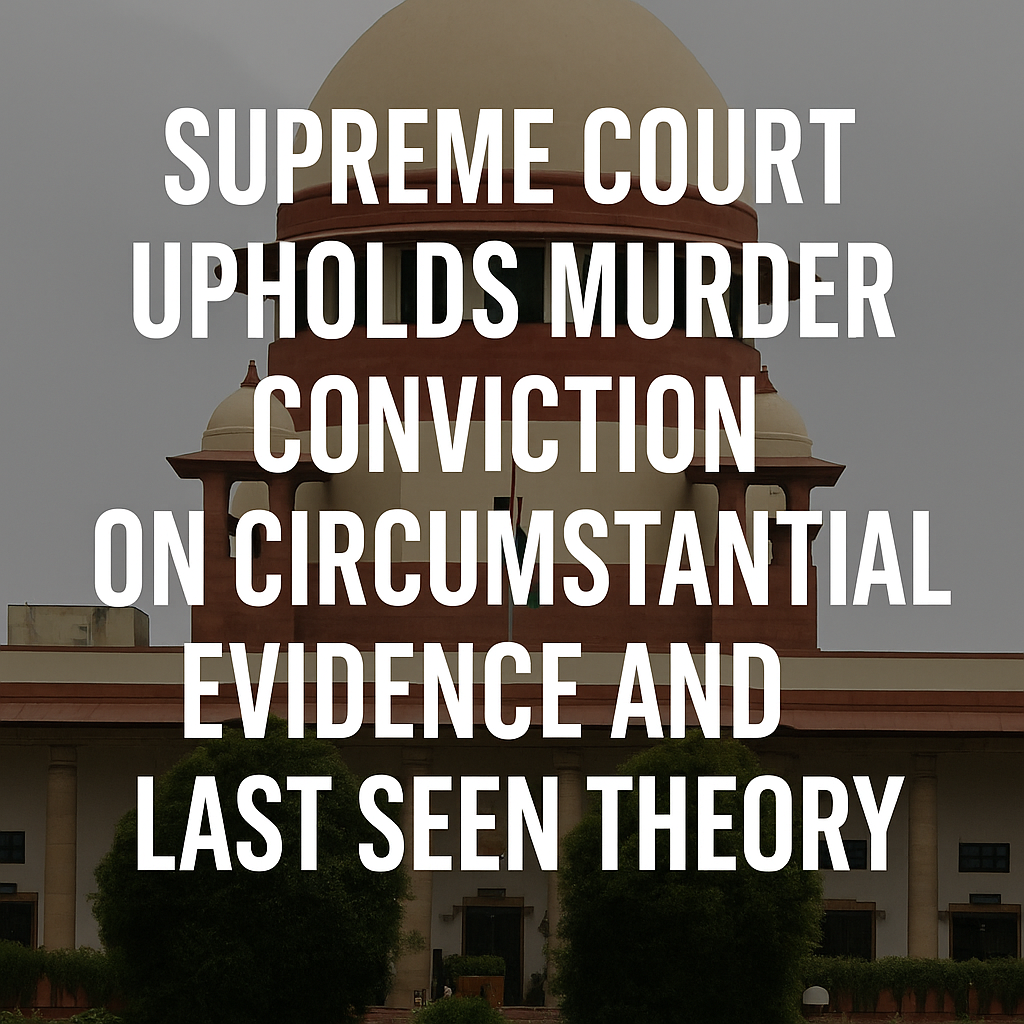The Supreme Court of India recently delivered a significant judgment in the criminal appeal Chetan v. State of Karnataka (2025 INSC 793), reinforcing crucial principles related to conviction based on circumstantial evidence and the “last seen” theory. The Court’s detailed analysis underscores the rigorous scrutiny required when direct evidence is absent, and provides authoritative guidance for criminal jurisprudence in India.
Background of the Case
The appellant, Chetan, was convicted for the murder of his friend Vikram Shinde under Section 302 of the Indian Penal Code, alongside charges under Sections 404 IPC and various provisions of the Arms Act. The deceased was found dead in a sugarcane field, with fatal gunshot injuries. The prosecution case relied heavily on circumstantial evidence, including testimony that the accused was last seen with the deceased before the latter’s death, recovery of the murder weapon at the accused’s instance, forensic ballistic evidence, and the accused’s subsequent abscondence.
Legal Issues Addressed
The Supreme Court primarily examined:
- The sufficiency and reliability of circumstantial evidence to uphold a conviction.
- The applicability and scope of the “last seen” theory in establishing the accused’s guilt.
- The role of forensic and ballistic evidence in corroborating circumstantial facts.
- The impact of absence of motive and credibility challenges to witnesses on the prosecution’s case.
Principles on Circumstantial Evidence
The Court reiterated the well-established five golden principles from Sharad Birdhichand Sarda v. State of Maharashtra (1984) which govern trials based on circumstantial evidence:
- All circumstances must be fully established.
- The facts must be consistent only with the guilt of the accused.
- The circumstances should be conclusive in nature and tendency.
- All other hypotheses must be excluded.
- The chain of evidence must be complete, leaving no reasonable ground for a conclusion consistent with innocence.
The Court observed that these principles ensure a high threshold to convict solely on circumstantial evidence, preventing conviction based on conjecture.
The “Last Seen” Theory and Time Gap
The judgment extensively analyzed the “last seen” theory, which posits that if the accused is last seen with the deceased shortly before death, and the deceased is found dead thereafter, the accused may be implicated unless reasonable doubt is shown.
The Court clarified that while a short time gap between last seen and death strengthens the inference of guilt, a longer gap does not automatically negate the theory if the prosecution shows there was no third-party interference. The Court relied on precedents like State of Goa v. Sanjay Thakran (2007) to explain that the applicability depends on the facts and circumstances of each case.
In Chetan, the deceased was last seen with the appellant on the night of 10th July 2006, and the dead body was discovered on 13th July 2006. The Court held that the 3-4 day gap was not fatal since the place where the body was found was secluded and rarely visited, making third-party involvement improbable.
Forensic and Ballistic Evidence as Crucial Link
Scientific evidence played a vital role in the Court’s affirmation of the conviction. The double barrel gun recovered at the appellant’s instance was found functional and linked through ballistic examination to pellets and wads recovered from the deceased’s skull. This forensic link was crucial to establish that the accused had caused the fatal injury.
Absence of Motive and Witness Credibility
The Court noted that absence of motive, while relevant, is not decisive when the other evidence overwhelmingly supports guilt. Although the Trial Court had doubts about the monetary transaction motive, the totality of circumstances was sufficient.
Regarding witnesses, the Court held that “chance witnesses” who happen to be present at the crime scene cannot be lightly disbelieved merely because their presence was incidental. Testimony of multiple witnesses, including relatives of the deceased and independent persons, consistently supported the last seen fact and the appellant’s presence.
Conclusion and Impact
The Supreme Court upheld the conviction and sentence of the appellant, emphasizing that:
- Convictions on circumstantial evidence require a complete and consistent chain excluding all other hypotheses.
- The last seen theory remains a potent legal tool but must be applied with care, considering time gaps and contextual evidence.
- Forensic and ballistic evidence can be determinative in linking accused to the crime.
- Witness testimony, even from chance witnesses, deserves careful judicial evaluation and cannot be disregarded solely on technical grounds.
This judgment serves as an authoritative guide for courts, prosecutors, and defense advocates in handling complex homicide cases where direct evidence is lacking. It balances the rights of the accused with the need for effective criminal justice and sets a precedent for rigorous application of circumstantial evidence principles under Indian law.




More Stories
The Arbitral Tribunal has no jurisdiction to apply the principle of Liberal Construction in interpreting the terms of the Contract- SC Ruled
The Court is not bound to follow statute or rules of evidence while deciding the custody of a Child and the only consideration should be the welfare and well-being of the child- Supreme Court Reiterated
When the Agreement specifies particular type/mode of constitution of Arbitral Tribunal, the same should be followed in strict sense- Supreme Court clarified.